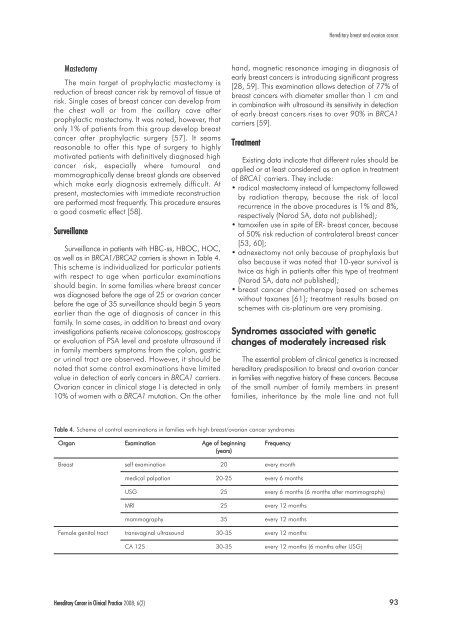Hereditary breast and ovarian cancer - BioMed Central
Hereditary breast and ovarian cancer - BioMed Central
Hereditary breast and ovarian cancer - BioMed Central
You also want an ePaper? Increase the reach of your titles
YUMPU automatically turns print PDFs into web optimized ePapers that Google loves.
<strong>Hereditary</strong> <strong>breast</strong> <strong>and</strong> <strong>ovarian</strong> <strong>cancer</strong>MastectomyThe main target of prophylactic mastectomy isreduction of <strong>breast</strong> <strong>cancer</strong> risk by removal of tissue atrisk. Single cases of <strong>breast</strong> <strong>cancer</strong> can develop fromthe chest wall or from the axillary cave afterprophylactic mastectomy. It was noted, however, thatonly 1% of patients from this group develop <strong>breast</strong><strong>cancer</strong> after prophylactic surgery [57]. It seamsreasonable to offer this type of surgery to highlymotivated patients with definitively diagnosed high<strong>cancer</strong> risk, especially where tumoural <strong>and</strong>mammographically dense <strong>breast</strong> gl<strong>and</strong>s are observedwhich make early diagnosis extremely difficult. Atpresent, mastectomies with immediate reconstructionare performed most frequently. This procedure ensuresa good cosmetic effect [58].SurveillanceSurveillance in patients with HBC-ss, HBOC, HOC,as well as in BRCA1/BRCA2 carriers is shown in Table 4.This scheme is individualized for particular patientswith respect to age when particular examinationsshould begin. In some families where <strong>breast</strong> <strong>cancer</strong>was diagnosed before the age of 25 or <strong>ovarian</strong> <strong>cancer</strong>before the age of 35 surveillance should begin 5 yearsearlier than the age of diagnosis of <strong>cancer</strong> in thisfamily. In some cases, in addition to <strong>breast</strong> <strong>and</strong> ovaryinvestigations patients receive colonoscopy, gastroscopyor evaluation of PSA level <strong>and</strong> prostate ultrasound ifin family members symptoms from the colon, gastricor urinal tract are observed. However, it should benoted that some control examinations have limitedvalue in detection of early <strong>cancer</strong>s in BRCA1 carriers.Ovarian <strong>cancer</strong> in clinical stage I is detected in only10% of women with a BRCA1 mutation. On the otherh<strong>and</strong>, magnetic resonance imaging in diagnosis ofearly <strong>breast</strong> <strong>cancer</strong>s is introducing significant progress[28, 59]. This examination allows detection of 77% of<strong>breast</strong> <strong>cancer</strong>s with diameter smaller than 1 cm <strong>and</strong>in combination with ultrasound its sensitivity in detectionof early <strong>breast</strong> <strong>cancer</strong>s rises to over 90% in BRCA1carriers [59].TreatmentExisting data indicate that different rules should beapplied or at least considered as an option in treatmentof BRCA1 carriers. They include:• radical mastectomy instead of lumpectomy followedby radiation therapy, because the risk of localrecurrence in the above procedures is 1% <strong>and</strong> 8%,respectively (Narod SA, data not published);• tamoxifen use in spite of ER- <strong>breast</strong> <strong>cancer</strong>, becauseof 50% risk reduction of contralateral <strong>breast</strong> <strong>cancer</strong>[53, 60];• adnexectomy not only because of prophylaxis butalso because it was noted that 10-year survival istwice as high in patients after this type of treatment(Narod SA, data not published);• <strong>breast</strong> <strong>cancer</strong> chemotherapy based on schemeswithout taxanes [61]; treatment results based onschemes with cis-platinum are very promising.Syndromes associated with geneticchanges of moderately increased riskThe essential problem of clinical genetics is increasedhereditary predisposition to <strong>breast</strong> <strong>and</strong> <strong>ovarian</strong> <strong>cancer</strong>in families with negative history of these <strong>cancer</strong>s. Becauseof the small number of family members in presentfamilies, inheritance by the male line <strong>and</strong> not fullTable 4. Scheme of control examinations in families with high <strong>breast</strong>/<strong>ovarian</strong> <strong>cancer</strong> syndromesOrgan Examination Age of beginning Frequency(years)Breast self examination 20 every monthmedical palpation 20-25 every 6 monthsUSG 25 every 6 months (6 months after mammography)MRI 25 every 12 monthsmammography 35 every 12 monthsFemale genital tract transvaginal ultrasound 30-35 every 12 monthsCA 125 30-35 every 12 months (6 months after USG)<strong>Hereditary</strong> Cancer in Clinical Practice 2008; 6(2) 93




